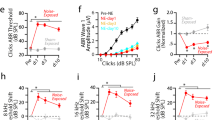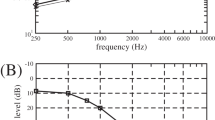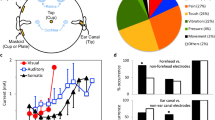Abstract
Brain changes in response to nerve damage or cochlear trauma can generate pathological neural activity that is believed to be responsible for many types of chronic pain and tinnitus1,2,3. Several studies have reported that the severity of chronic pain and tinnitus is correlated with the degree of map reorganization in somatosensory and auditory cortex, respectively1,4. Direct electrical or transcranial magnetic stimulation of sensory cortex can temporarily disrupt these phantom sensations5. However, there is as yet no direct evidence for a causal role of plasticity in the generation of pain or tinnitus. Here we report evidence that reversing the brain changes responsible can eliminate the perceptual impairment in an animal model of noise-induced tinnitus. Exposure to intense noise degrades the frequency tuning of auditory cortex neurons and increases cortical synchronization. Repeatedly pairing tones with brief pulses of vagus nerve stimulation completely eliminated the physiological and behavioural correlates of tinnitus in noise-exposed rats. These improvements persisted for weeks after the end of therapy. This method for restoring neural activity to normal may be applicable to a variety of neurological disorders.
This is a preview of subscription content, access via your institution
Access options
Subscribe to this journal
Receive 51 print issues and online access
$199.00 per year
only $3.90 per issue
Buy this article
- Purchase on Springer Link
- Instant access to full article PDF
Prices may be subject to local taxes which are calculated during checkout




Similar content being viewed by others
References
Flor, H. Phantom-limb pain as a perceptual correlate of cortical reorganization following arm amputation. Nature 375, 482–484 (1995)
Eggermont, J. J. & Roberts, L. E. The neuroscience of tinnitus. Trends Neurosci. 27, 676–682 (2004)
Møller, A. R. Tinnitus and pain. Prog. Brain Res. 166, 47–53 (2007)
Mühlnickel, W., Elbert, T., Taub, E. & Flor, H. Reorganization of auditory cortex in tinnitus. Proc. Natl Acad. Sci. USA 95, 10340–10343 (1998)
De Ridder, D., De Mulder, D., Menovsky, T., Sunaert, S. & Kovacs, S. Electrical stimulation of auditory and somatosensory cortices for treatment of tinnitus and pain. Prog. Brain Res. 166, 377–388 (2007)
Okamoto, H., Stracke, H., Stoll, W. & Pantev, C. Listening to tailor-made notched music reduces tinnitus loudness and tinnitus-related auditory cortex activity. Proc. Natl Acad. Sci. USA 107, 1207–1210 (2010)
Flor, H., Denke, C., Schaefer, M. & Grüsser, S. Effect of sensory discrimination training on cortical reorganization and phantom limb pain. Lancet 357, 1763–1764 (2001)
Kilgard, M. P. & Merzenich, M. M. Cortical map reorganization enabled by nucleus basalis activity. Science 279, 1714–1718 (1998)
Dorr, A. E. & Debonnel, G. Effect of vagus nerve stimulation on serotonergic and noradrenergic transmission. J. Pharmacol. Exp. Ther. 318, 890–898 (2006)
Clark, K. B., Naritoku, D. K., Smith, D. C., Browning, R. A. & Jensen, R. A. Enhanced recognition memory following vagus nerve stimulation in human subjects. Nature Neurosci. 2, 94–98 (1999)
Bao, S., Chan, V. T. & Merzenich, N. M. Cortical remodelling induced by activity of ventral tegmental dopamine neurons. Nature 412, 79–83 (2001)
Bollinger, J. J. Adult Auditory Cortical Plasticity Modulated by Locus Coeruleus Activity. PhD thesis, Univ. California San Francisco. (2006)
Ben-Menachem, E. Vagus nerve stimulation, side effects, and long-term safety. J. Clin. Neurophysiol. 18, 415–418 (2001)
Noreña, A. J., Tomita, M. & Eggermont, J. J. Neural changes in cat auditory cortex after a transient pure-tone trauma. J. Neurophysiol. 90, 2387–2401 (2003)
Salvi, R. J., Wang, J. & Ding, D. Auditory plasticity and hyperactivity following cochlear damage. Hear. Res. 147, 261–274 (2000)
Eggermont, J. in Tinnitus: Pathophysiology and Treatment (eds Langguth, B., Hajak, G., Kleinjung, T., Cacace, A., & Møller, A. R. ) 19–35 (Prog. Brain Res. 166, Elsevier, 2007)
Turner, J. G. et al. Gap detection deficits in rats with tinnitus: a potential novel screening tool. Behav. Neurosci. 120, 188–195 (2006)
Murphy, W. J. & van Campen, L. E. Temporary threshold shift in ABRs and DPOAEs following noise exposure in Long–Evans rats. J. Acoust. Soc. Am. 109, 2373 (2001)
Bauer, C. A., Turner, J. G., Caspary, D. M., Myers, K. S. & Brozoski, T. J. Tinnitus and inferior colliculus activity in chinchillas related to three distinct patterns of cochlear trauma. J. Neurosci. Res. 86, 2564–2578 (2008)
Bauer, C. A. & Brozoski, T. J. Assessing tinnitus and prospective tinnitus therapeutics using a psychophysical animal model. J. Assoc. Res. Otolaryngol. 2, 54–64 (2001)
Lobarinas, E., Sun, W., Cushing, R. & Salvi, R. A novel behavioral paradigm for assessing tinnitus using schedule-induced polydipsia avoidance conditioning (SIP-AC). Hear. Res. 190, 109–114 (2004)
Moore, B. C. & Sandhya, V. The relationship between tinnitus pitch and the edge frequency of the audiogram in individuals with hearing impairment and tonal tinnitus. Hear. Res. 261, 51–56 (2010)
Yang, G. et al. Salicylate induced tinnitus: behavioral measures and neural activity in auditory cortex of awake rats. Hear. Res. 226, 244–253 (2007)
Noreña, A. J. & Eggermont, J. J. Enriched acoustic environment after noise trauma reduces hearing loss and prevents cortical map reorganization. J. Neurosci. 25, 699–705 (2005)
Kilgard, M. P., Vazquez, J. L., Engineer, N. D. & Pandya, P. K. Experience dependent plasticity alters cortical synchronization. Hear. Res. 229, 171–79 (2007)
Dietrich, V., Nieschalk, M., Stoll, W., Rajan, R. & Pantev, C. Cortical reorganization in patients with high frequency cochlear hearing loss. Hear. Res. 158, 95–101 (2001)
Dauman, R. & Cazals, Y. Auditory frequency selectivity and tinnitus. Arch. Otorhinolaryngol. 246, 252–255 (1989)
Kaltenbach, J. A. & Afman, C. E. Hyperactivity in the dorsal cochlear nucleus after intense sound exposure and its resemblance to tone-evoked activity: a physiological model for tinnitus. Hear. Res. 140, 165–172 (2000)
Diesch, E., Andermann, M., Flor, H. & Rupp, A. Interaction among the components of multiple auditory steady-state responses: enhancement in tinnitus patients, inhibition in controls. Neuroscience 167, 540–553 (2010)
Bauer, C. A., Brozoski, T. J. & Myers, K. Primary afferent dendrite degeneration as a cause of tinnitus. J. Neurosci. Res. 85, 1489–1498 (2007)
König, O., Schaette, R., Kempter, R. & Gross, M. Course of hearing loss and occurrence of tinnitus. Hear. Res. 221, 59–64 (2006)
Burns, E. M. A comparison of variability among measurements of subjective tinnitus and objective stimuli. Audiology 23, 426–440 (1984)
Ochi, K., Ohashi, T. & Kenmochi, M. Hearing impairment and tinnitus pitch in patients with unilateral tinnitus: comparison of sudden hearing loss and chronic tinnitus. Laryngoscope 113, 427–431 (2003)
Engineer, N. D. et al. Environmental enrichment improves response strength, threshold, selectivity, and latency of auditory cortex neurons. J. Neurophysiol. 92, 73–82 (2004)
Acknowledgements
We would like to thank A. Kuzu, J. Omana, D. Vuppala, H. Rasul, M. Fink, E. Hanacik, R. Miller and C. Walker for help with rat behavioural training. We would also like to thank J. Eggermont, A. Møller, C. Bauer, J. Fritz, H. Reed, C. Engineer, A. Reed, M. Brosch, R. Rennaker, R. Beitel, V. Miller, C. McIntyre, G. White, P. Pandya, R. Tyler and D. deRidder for suggestions about earlier versions of the manuscript. This work was supported by the James S. McDonnell Foundation, the Texas Advanced Research Program, the National Institute for Deafness and other Communication Disorders, and MicroTransponder Inc.
Author information
Authors and Affiliations
Contributions
N.D.E., J.R.R., J.D.S., S.P.S. and M.S.B. did the behaviour training sessions, noise exposure and auditory brainstem response recordings. N.D.E., J.R.R., J.D.S., W.A.V. and J.A.S. did cortical microelectrode mappings. J.A.S. did the A1 mapping surgeries. S.P.S. and N.D.E. did all the VNS implant surgeries. M.P.K. and N.D.E. designed the experiments, wrote the manuscript and performed data analysis. All authors discussed the paper and commented on the manuscript.
Corresponding author
Ethics declarations
Competing interests
N.D.E. is a full-time employee of MicroTransponder Inc (Austin, Texas), which develops therapies using neurostimulation. M.P.K. is a consultant and shareholder of MicroTransponder Inc.
Supplementary information
Supplementary Information
The file contains a Supplementary Discussion, additional references and Supplementary Figures 1-17 with legends. (PDF 1768 kb)
Rights and permissions
About this article
Cite this article
Engineer, N., Riley, J., Seale, J. et al. Reversing pathological neural activity using targeted plasticity. Nature 470, 101–104 (2011). https://doi.org/10.1038/nature09656
Received:
Accepted:
Published:
Issue Date:
DOI: https://doi.org/10.1038/nature09656
This article is cited by
-
Degraded inferior colliculus responses to complex sounds in prenatally exposed VPA rats
Journal of Neurodevelopmental Disorders (2024)
-
Neurostimulation for treatment of post-stroke impairments
Nature Reviews Neurology (2024)
-
Vagus nerve stimulation in the non-human primate: implantation methodology, characterization of nerve anatomy, target engagement and experimental applications
Bioelectronic Medicine (2023)
-
Plastic Changes Induced by Motor Activity in Spinal Cord Injury
Neuroscience and Behavioral Physiology (2023)
-
Eavesdropping on Tinnitus Using MEG: Lessons Learned and Future Perspectives
Journal of the Association for Research in Otolaryngology (2023)
Comments
By submitting a comment you agree to abide by our Terms and Community Guidelines. If you find something abusive or that does not comply with our terms or guidelines please flag it as inappropriate.



